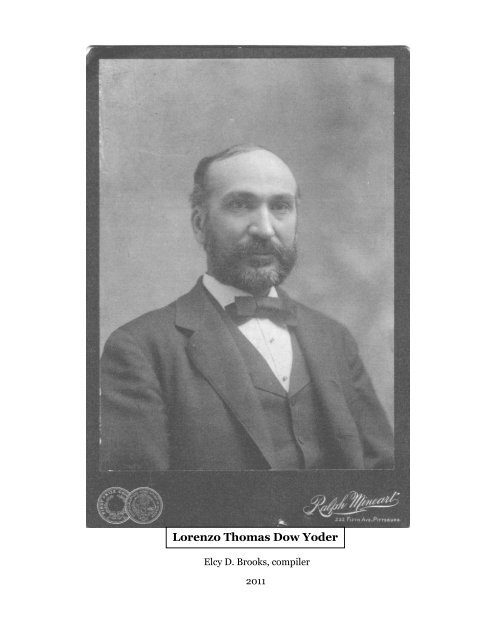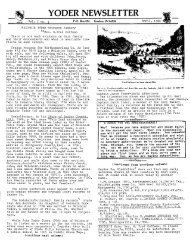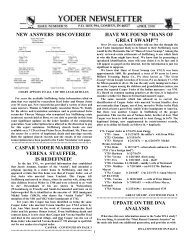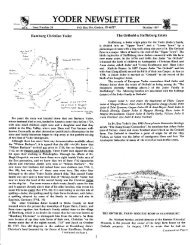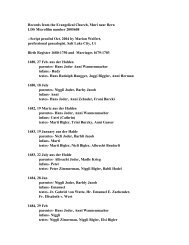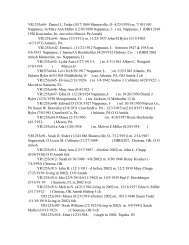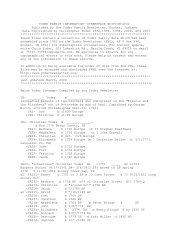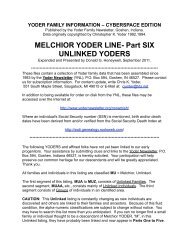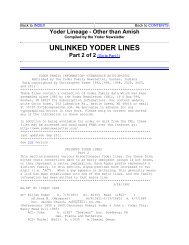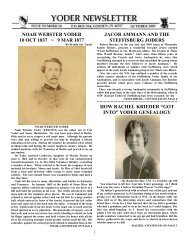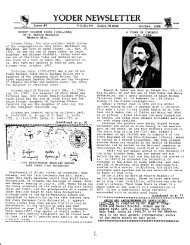Lorenzo Thomas Dow Yoder - Yoder Family Information
Lorenzo Thomas Dow Yoder - Yoder Family Information
Lorenzo Thomas Dow Yoder - Yoder Family Information
- No tags were found...
You also want an ePaper? Increase the reach of your titles
YUMPU automatically turns print PDFs into web optimized ePapers that Google loves.
<strong>Lorenzo</strong> <strong>Thomas</strong> <strong>Dow</strong> <strong>Yoder</strong><br />
Elcy D. Brooks, compiler<br />
2011<br />
1847 - 1926
THE OLEY VALLEY YODERS OF PENNSYLVANIA<br />
Including a Biography of <strong>Lorenzo</strong> <strong>Thomas</strong> <strong>Yoder</strong><br />
1847 - 1926<br />
The <strong>Yoder</strong> families of Pennsylvania are of Swiss origin, many of whom were<br />
residents of Steffisburg, Switzerland and surrounding areas. There were, and are, others<br />
of the <strong>Yoder</strong> name in Switzerland but they are not related to this particular family branch.<br />
The <strong>Yoder</strong>s who established themselves in America represented three separate but closely<br />
related groups - Reformed, Mennonite and Amish. Many were known as AAnabaptists@<br />
because they did not agree with the Swiss church=s insistence on infant baptism, and so<br />
were fined and castigated for this. Thus, they felt they must immigrate to other countries<br />
and places to escape religious persecution. The name appears in a variety of spellings -<br />
AJotter@ being the preferred spelling in Switzerland and A<strong>Yoder</strong>@ in America. (It also can<br />
appear as AJotter@, AYotter@, AJetter@, AYouther@ etc.) All Pennsylvania <strong>Yoder</strong>s can claim a<br />
relationship to each other, regardless of whether Reformed, Mennonite or Amish. It is a<br />
very large family and numerous offshoots are to be found in Central New York, the<br />
Carolinas, the Appalachians and the Midwest.<br />
The Oley Valley <strong>Yoder</strong>s established themselves in Pennsylvania under the<br />
Willliam Penn Act before the territory officially became a state. The original immigrant<br />
to Pennsylvania was Jost or Yost <strong>Yoder</strong> who settled on the Nanatawny Creek, near where<br />
Pleasantville is now situated, in the Oley Valley of Oley Township, in the Reading area of<br />
Berks County, Pennsylvania. He was one of three brothers who left Switzerland. One<br />
settled in South Carolina and one in Ohio. The descendants of Jost have ever since been<br />
identified as Athe Oley Valley <strong>Yoder</strong>s@. The ancient burial place of the <strong>Yoder</strong>s is at<br />
Pleasantville - called by the German speakers, AYotterstettle@ - which forms the extreme<br />
eastern end of Union Cemetery. Because of the steep terrains and abundance of water in<br />
Switzerland, many of the family operated mills of various kinds and so it was natural that<br />
- 1 -
their descendants<br />
would do the Berks County<br />
same. The<br />
<strong>Yoder</strong> properties<br />
in the Oley<br />
Valley and<br />
elsewere in the<br />
Allegheny<br />
Mountains had<br />
an abundance of<br />
water power and<br />
milling was a<br />
logical way to<br />
earn a living - grist mills, saw mills, fulling mills and paper mills.<br />
Yost <strong>Yoder</strong>01, the immigrant, is remembered in Pennsylvania legend as a mighty<br />
hunter and trapper. He is said to have made hunting excursions in and beyond the Blue<br />
Mountains of the Alleghenys in what was then Indian country - and is now Schuylkill<br />
County. Friendly Indians still lived in the Oley Valley when the first families arrived.<br />
Several of the second-generation <strong>Yoder</strong>s learned and could speak Delaware language.<br />
Many of Yost=s family were rough and ready frontiersmen, so much so that an old<br />
description of such a person was Asomeone like Yost/Hans@. Yost <strong>Yoder</strong> made his will 29<br />
May 1741 and, since he could not write, made his mark. The will is on record in the<br />
Philadelphia Archives. Yost <strong>Yoder</strong> and his descendants were of the Reformed<br />
persuasion. In generational order, they were: Yost <strong>Yoder</strong>01, 1679-1741; Jacob <strong>Yoder</strong>02,<br />
1735-1803; Peter <strong>Yoder</strong>03, 1769-1817; Daniel <strong>Yoder</strong>04, 1789-1871; Charles <strong>Thomas</strong><br />
<strong>Yoder</strong>05, 1815-1851; <strong>Lorenzo</strong> <strong>Thomas</strong> <strong>Yoder</strong>06, 1847-1926; and Elcy Kennedy<br />
<strong>Yoder</strong>07, 1904-1974.<br />
- 2 -
Jacob <strong>Yoder</strong>02 was born in 1735 in Berks County. He was just seven years of age<br />
at the death of his father. He married Maria (Keim), the daughter of Johannes Keim, a<br />
Huguenot. At the age of 22, he enlisted in the Provincial Service of Pennsylvania where<br />
he was a saddler for three years in Captain John Nicholas Weatherholt=s Company which<br />
was stationed in Heidelberg Township, Northampton County, PA. He later served in the<br />
American Revolution as a private in Peter Nagle=s Company and later in Captain Charles<br />
Gobins= militia. He was part of a detachment of the Sixth Battalion whose orders were to<br />
guard prisoners of war from the Hessian camp on its march from Reading to Philadelphia.<br />
Jacob and Maria were prosperous farmers, owning 74 acres of land in 1767. By 1768 he<br />
owned 160 acres, 2 horses, 5 cattle and 3 sheep. Sixteen years later he owned 200 acres,<br />
4 horses, 8 cows and 11 sheep. He died in 1803, naming twelve children in his will.<br />
Peter <strong>Yoder</strong>03 was born in Berks County and married Anna (Oyster) in 1784. He<br />
died intestate in 1818, leaving eight children and a farm of 156 acres in Pike Township,<br />
Berks County, PA.<br />
Daniel <strong>Yoder</strong>04 was also born in Berks County and married Mary (LaRosa) in<br />
1815. They removed to a farm near Orwigsburg, Skuylkill County, PA in 1825. The<br />
family moved again in 1850 to Pottsville, Pennsylvania where he died in 1871. His will is<br />
dated 1866 and names seven children.<br />
Charles <strong>Thomas</strong> <strong>Yoder</strong>05 was born in Schuylkill County, PA, the eldest of four<br />
brothers and three sisters. He was trained as a watchmaker and engraver and, with<br />
patience and persistence, he established a reputation for highly skilled work. About 1830,<br />
wishing to start his own business in a new location, he left Schuylkill County, crossing the<br />
Allegheny Mountains by wagon - the trip taking about a week - and settled in the growing<br />
city of Pittsburgh at the confluence of the Allegheny and Monongahela Rivers. Here he<br />
was married to Ann Elizabeth (Kennedy) in 1842 by the Reverend Mr. Brown in the<br />
Smithfield Street Methodist Church. She was the daughter of <strong>Thomas</strong> Kennedy Sr. The<br />
Kennedy family was descended from an old and genteel line of landowners and noted<br />
- 3 -
warriors - the American progenitor being <strong>Thomas</strong> Kennedy Sr. who came to America from<br />
Scotland in 1804 and established a looking glass and mirror factory in Baltimore,<br />
Maryland. It was here that Ann Elizabeth was born. As a little girl, she traveled across<br />
the Allegheny Mountains on what was then called the National Pike (old Route 40 today)<br />
in a Conestoga wagon, drawn by two horses, and accompanied by her father and her older<br />
brother, <strong>Thomas</strong> Kennedy Jr. In the words of her son, <strong>Lorenzo</strong>, Athey came by way of<br />
Brownsville where her father had some notion of locating.<br />
Charles <strong>Thomas</strong> <strong>Yoder</strong><br />
- 4 -
Standing: Charles & Hamilton<br />
Seated: Francis, Ann Elizabeth &<br />
<strong>Lorenzo</strong><br />
but looking over the town and location,<br />
he concluded to go on to Pittsburgh.<br />
Grandfather Kennedy had great regard<br />
and high esteem for his family and was<br />
very particular as to the company they should associate with, and he made some objections<br />
to Father when he commenced paying attention to Mother - thinking Father was not good<br />
enough for his daughter Ann, as he called her. But true love stops for no object in the way<br />
- as greater the difficulty, the more determined to marry - so they were married and all<br />
objection ceased,@. (<strong>Thomas</strong> Kennedy Sr died in 1865.) Four children were born to<br />
Charles and Ann Elizabeth: Charles Theodore <strong>Yoder</strong> 1843 - 1915; Hamilton Wright <strong>Yoder</strong><br />
1844-1876; <strong>Lorenzo</strong> <strong>Thomas</strong> <strong>Yoder</strong> 1847-1926; and Frances Ann 1850-1912. For about<br />
ten years Charles worked to establish his reputation. He had all the work he could do, not<br />
only from those who visited his shop, but from other jewelers who were obliged to bring<br />
their delicate work to him for his skilled abilities.<br />
- 5 -
His first location was in a two-story log structure on Fifth Avenue, between Wood<br />
and Smithfield Streets. The building was veneered with weathered boards, providing a<br />
shop in which to work on the first level with adequate family living quarters on the floor<br />
above.<br />
The site was considered, at the time, to be the central business district of the city.<br />
The family lived happily and comfortably enough, although the business increased so<br />
much that Charles was compelled to work longer and longer hours with little or no<br />
exercise. His son, <strong>Lorenzo</strong>, writing a biography in later years, described his father as a<br />
Agood provider who worked long hours@. The only open air exercise his father had was<br />
Agoing to the old Market on Wood Street where he would procure a basketful of eatables,<br />
with quite a large fish strung on the outside of the basket@.<br />
In 1845 a catastrophic fire occurred in Pittsburgh, destroying nearly half the town<br />
including their home and engraving business. Survivors had no place to put their rescued<br />
belongings and furniture except a vacant square - the only place of safety. Here the<br />
citizens piled their belongings, waiting nearly a year before a proper separation was made.<br />
Charles and his family moved themselves and their business to the corner of Sixth Avenue<br />
and Smithfield Street - just a short distance away from their first home.<br />
- 6 -
1845 Fire<br />
Area<br />
The holocaust began around noon on 10 April 1845 in the ice house of Colonel<br />
William Diehl. It was believed that it started after a washerwoman lit a fire for her<br />
laundry in a woodshed adjoining Colonel Diehl=s residence. Soon the bells of the Third<br />
Presbyterian Church sounded the alarm, but by then the wind had already taken the flames<br />
eastward and building after wooden building were crackling and burning. AA pretty<br />
strong wind was blowing from the west,@ wrote Attorney Robert McKnight in his diary,<br />
Aand some alarm existed as to the spread of the flames. I mounted an engine and labored<br />
with might and main but unfortunately the supply of water failed!@ There was confusion<br />
everywhere, noted the diarist, Adrays, carts, furniture, horses and men were running in all<br />
directions@. The fire moved from block to block devastating all in its path. Businessmen<br />
inside the fire area worked in a frantic effort to move their stock of goods out of their stores<br />
and to places of safety. Those who were able carted their belongings to the bank of the<br />
Monongahela River, which Abecame piled up with an enormous and indescribable mass of<br />
- 7 -
matter@. At last, when the flames burned themselves out, the area between Ferry Street,<br />
Diamond Alley and Water Street on the Monongahela side, as far as the present Tenth<br />
Street Bridge, was devastated. More than 50 acres had become prey of the flames. Some<br />
estimates of the loss ran as high as nine million dollars. The Pittsburgh Gazette=s reporter<br />
wrote: ANothing was spared - very little saved. The progress of the fire as it lanced and<br />
leaped with its forked tongue from house to house, from block to block, and from square to<br />
square was awfully magnificent@.<br />
Sadly, the long hours at his workbench and his sedentary habits, coupled with the<br />
stress of the fire, brought on the first of a series of incapacitating paralytic strokes in 1849.<br />
Charles was never able to work again and from that time until his death in 1851, the family<br />
suffered financially - depleting their savings completely. In the meantime, Ann Elizabeth<br />
found work as a seamstress, supporting her invalided husband and four children as best she<br />
could. At the death of Charles they were left in a penniless condition. No longer able to<br />
pay the rent on their home, she sought another less expensive place in which to live. After<br />
some days, she found a four<br />
room frame house on Troy<br />
Hill in Allegheny City, just<br />
across the river from<br />
Pittsburgh. Here the three<br />
boys attended school and<br />
Elizabeth took baby Frances<br />
Ann to work with her each<br />
day, walking back into<br />
Pittsburgh to her work as a<br />
seamstress. She returned in<br />
the evenings, climbing<br />
- 8 -
ack up Troy Hill, to cook supper for the children - a tired and discouraged mother. She<br />
cared deeply for her children, counseling them and teaching them love of each other, of<br />
their fellow-man and of God. The boys adored their courageous, generous Mother. As<br />
<strong>Lorenzo</strong> wrote in his brief autobiography: AI am sure that no two persons could have<br />
enjoyed each other=s society more than did Mother and I, from the first time we became<br />
acquainted. I will admit that there were smacks once in a while that disturbed our peace,<br />
but our love was the stronger after it was all over......@. After several years, Ann Elizabeth<br />
realized that being a seamstress was not providing adequately for her little family and<br />
decided to go into business for herself. She and her children moved once more - this time<br />
to Sandusky Street, between Lacock and Robinson Streets on the Allegheny River. The<br />
edifice was a two story frame building containing three rooms above, and a store front<br />
below. It was located across the street from the Eagle Cotton Mill. Charles Theodore<br />
about ten, Hamilton nine and <strong>Lorenzo</strong> six were placed in the Fourth Ward School on<br />
Sandusky Street. Ann Elizabeth=s brother, <strong>Thomas</strong> Kennedy, had a profitable business<br />
selling notions at the corner of Wood Street and Third Avenue, and he agreed to supply his<br />
sister with merchandise for her little store. Stocked with a supply of notions, candy and<br />
other small wares, she sold the items to the girls working at the mill. The Eagle Cotton<br />
Mill employed about three hundred girls, called ACotton Bumpers.@ They had a great habit<br />
- 9 -
of rubbing snuff, which gave Ann Elizabeth quite a trade in this article. She purchased it<br />
by the bladder and sold it by the spoon. The Penn Cotton Mill was just a block away,<br />
employing about as many girls as the Eagle Mill, which added to the snuff demand. Using<br />
her skills as a seamstress, Ann Elizabeth stocked her shop with children=s clothes as well as<br />
aprons for the girls and men working in the mill. She also made all kinds of taffy which<br />
attracted passersby and children on their way to school. One of <strong>Lorenzo</strong>=s chores was<br />
shelling peanuts for the Apan taffy@. In his words, AI would slip a kernel or two in my<br />
mouth on the sly and they would taste good. Mother would let us children scrape the taffy<br />
pot. This was a greatly enjoyed treat and was sweet to our taste@. Somehow the family<br />
survived, despite unforeseen troubles which included another fire and the river which<br />
flooded frequently. Each boy did his part helping out in the shop when they were not in<br />
school, but their mother was adamant that an education came first. Thankfully, they were<br />
again somewhat financially safe and able to cope with daily surprises and disasters.<br />
Living so near the river which was prone to flood in the spring was a problem. As<br />
<strong>Lorenzo</strong> described it, AThe Allegheny River rose until the waters surrounded our house and<br />
we carried all the material from the store and kitchen to the upper floor. We were penned<br />
in for some days until the water subsided, but it left the cellar full of water and there was<br />
mud and sand all over the first floor. In time, we scraped and cleaned and finally got back<br />
to our normal condition. By degrees, the cotton mills started to run - partially at first and<br />
then under a full head of steam.@<br />
<strong>Lorenzo</strong>, a youngster armed with boundless energy and ambition, had a talent for<br />
inventiveness. In order to help his mother financially and with a necessarily limited<br />
education, (he dropped out of school in the Fifth Grade) <strong>Lorenzo</strong> did his best to make a<br />
living outside of his chores at home. His first job outside of the shop in 1856 was that of<br />
errand boy for the Sheppard Baking Company on Liberty Street. His stipend was $1.50 a<br />
week which was turned over promptly to his mother. At the age of 13, <strong>Lorenzo</strong> entered<br />
the employ of Reymer Brothers - a wholesale candy manufacturing company from<br />
- 10 -
Philadelphia, who had established a profitable retail business in Pittsburgh. He became a<br />
traveling salesman for the firm, selling and delivering orders from a horse and wagon and<br />
thus proceeded to learn the candy business from manufacturing to delivery. Seeing the<br />
need for a wholesale candy business in Pittsburgh, his ambition was to rise in the company<br />
and make and save enough money for the time when he could start a business for himself.<br />
He became, over time, Reymer=s best salesman, saving enough money that enabled him to<br />
do so in 1873 at age 26<br />
Through the ability and energy of its founder, the L. T. <strong>Yoder</strong> Candy Company<br />
prospered inspite of a general financial depression in the country. He hired three salesmen<br />
who proved to be so successful that in 1889 he took them into<br />
L. T. <strong>Yoder</strong><br />
partnership - E. J. Weaver, C. W. Costello and J. C. Patch.<br />
The re-organized company was known as the <strong>Yoder</strong>, Weaver<br />
& Costello Company. Undoubtedly the company=s success<br />
was in no small measure a result of <strong>Lorenzo</strong>=s invention of a<br />
ribbon candy machine which he patented in December 1883,<br />
#289,488. It consisted<br />
of a new improved and<br />
less expensive method<br />
of candy production<br />
since it required only one employee to operate. In<br />
his words: AI take the candy in its plastic state and<br />
>spin= or form it into long, thin narrow strips, which<br />
are then bent sideways in alternate directions in<br />
planes at right angles to the length of the strip@. He<br />
sold the machine all over the world, helping him to<br />
amass a considerable fortune. By 1891 his<br />
company was one of the strongest and largest<br />
- 11 -
concerns of its kind in Pittsburgh, with a range of territory which covered Western<br />
Pennsylvania, Eastern Ohio and West Virginia - its products being candy and<br />
confectionery. In addition to his invention, he formulated his own candy recipes,<br />
improving on his mother=s taffy recipe, including one for horehound drops which were<br />
extremely popular as a cough remedy. Best of all, his mother no longer had to worry<br />
about the future of her family. The little shop near the Eagle Cotton Mill was a thing of<br />
the past. It was with the greatest pride and pleasure that Ann Elizabeth was able to see and<br />
participate in her son=s achievements.<br />
Ann Elizabeth (Kennedy) <strong>Yoder</strong> died in 1894. She and her husband, Charles<br />
<strong>Thomas</strong> <strong>Yoder</strong>, are buried in Allegheny Cemetery, Section 23, Lot 95 in Pittsburgh.<br />
With new horizons to reach and boundless ambition, <strong>Lorenzo</strong> ultimately sold his<br />
candy manufacturing interest to two of his salesmen - Weaver and Costello - and devoted<br />
himself to real estate and financial matters. He organized and became president and chief<br />
owner of the <strong>Yoder</strong> Land Company which was capitalized at $200,000. The company<br />
was occupied with the purchase of unimproved properties in various sections of a growing<br />
Pittsburgh, as well as the laying out of streets and the building and sale of houses. He was<br />
also principal owner of West Penn Gas Company, capitalized at $275,000, which provided<br />
fuel to new and existing mills from Apollo to Tarentum in the Kiskiminitas and Allegheny<br />
River valleys. He served as president of the gas company Board of Directors for many<br />
years. It was during this time that he built as his permanent residence, a large home at 1232<br />
Murray Hill Avenue where he raised his children. The edifice was of his own design,<br />
containing thirteen rooms, including two baths (one tiled), a conservatory, a library, a<br />
nursery, and hot water heat.<br />
- 12 -
1232 Murry Hill Avenue<br />
<strong>Lorenzo</strong>=s business acumen was only part of his life=s endeavors. He was a<br />
practicing humanitarian and genuine Christian, endowing all he did with the essence of<br />
true religion. As a staunch advocate of prohibition, in 1876 he aided in the fight which led<br />
to passage of the 18 th Constitutional Amendment in 1917. It was both his desire to further<br />
this movement and a devastating depression which led him to purchase ground at 1112<br />
Forbes Avenue in Pittsburgh and erect the four hundred room <strong>Yoder</strong> Hotel: “For men<br />
Only-No Liquors Sold on the Premises – Single Room $1.50 Per Week”. was fireproof and<br />
easily adapted for change into an office building. The prices of from twenty-five cents to<br />
one dollar and a half indicate the plan on which the hotel was run - good clean, wholesome<br />
living service, without the temptations of liquor - to provide, in a time of economic<br />
depression, out-of-work men who needed decent living conditions to put them on their feet<br />
and give them a fresh start. His last twenty years were devoted to this work. The hotel<br />
gained a reputation for welcoming all men and treating them humanely. Recalling his<br />
own impoverished beginnings, he would often come to the aid of his fellow man in<br />
unexpected ways. <strong>Lorenzo</strong> had the satisfaction in after-years of hearing from many a<br />
happy and prosperous man who said that both the physical and spiritual bolstering he<br />
received from Mr. <strong>Yoder</strong>, provided him the strength to make the hard fight to success.<br />
And there were others - the ill-shod newsboys who delivered his daily paper and came to<br />
collect for a week=s delivery, were just as likely to depart with the price of a new pair of<br />
- 13 -
shoes as well as the cost of the papers. He encouraged them to get a financial start in life<br />
by an offer to duplicate, at the end of each year, whatever amount the newsboy had saved in<br />
that year=s time!<br />
Personally, <strong>Lorenzo</strong> was a fiercely devout Methodist, rising from his seat during the<br />
service to shout AAmen, brother@, when he felt strongly about the pastor=s message - much<br />
to the embarrassment of his daughters. For many years, <strong>Lorenzo</strong> was a member of the<br />
Smithfield Methodist Episcopal Church where he taught Sunday School. Blue was his<br />
favorite color and he had a suit made of blue serge, but of a hue so bright that his wife made<br />
him return it, feeling it was not fit for a man of his position! He did not believe in card<br />
playing, nor would he permit a deck in his house, believing they were instruments of the<br />
devil. His daughters, as young women, were forced to invent Aacceptable@ social events<br />
when they were, in reality, going to a bridge tea. He did not believe women were ready<br />
for marriage until in their thirties, and was not pleased that his two eldest daughters married<br />
much before that age. He loved to sing and was possessed of a pleasant tenor voice.<br />
On the other hand, he was not without his eccentricities. His one vice - if it could<br />
be called that - was billiards. He was obsessed by the game and, when he could afford it,<br />
he had a full-sized table installed - out of sight - in his attic, for he was not anxious that<br />
others should find out about this pastime! He had a favorite derby hat which he wore on<br />
nearly every occasion - and he had a passion for coconut meat. One very rainy day he was<br />
crossing a major street in Pittsburgh, with his hat on his head, an umbrella in one hand and<br />
a paper sack which contained a coconut in the other. A gust of wind threatened his hat<br />
and, not wishing to drop the umbrella, he threw up the hand which held the coconut - and<br />
knocked himself out in the middle of the street! He always carried a few bills of<br />
Confederate money in his wallet. One day he boarded a trolley car and discovered he had<br />
no other money with which to pay his fare. Fortunately, the trolley conductor recognized<br />
him as a passenger from many other trips and let him ride anyway! Outside of his<br />
personal home life, he was a member of the Independent Order of Odd Fellows and a<br />
- 14 -
charter member of the Oakland Lodge, No.530, Free and Accepted Masons where he<br />
participated in their good works. Another favorite project was the organization of the<br />
Home for Working Girls in Pittsburgh, which ultimately was absorbed by the Young<br />
Women=s Christian Association. He was also a charter member and active aid in the<br />
management of the Industrial Home for Boys at Oakmont, Pennsylvania. In 1881 he<br />
participated, with four other like-minded men from Wheeling, West Virginia - all<br />
prominent Methodists - in the establishment of a Chautauqua-type resort in Mountain Lake<br />
Park, Garrett County, Maryland, to be conducted as a Methodist religious summer<br />
colony.The founders of Mountain Lake Park incorporated themselves in 1881 as the<br />
Mountain Lake Park Association and issued stock, initially fifteen shares at $1,000. As<br />
investors in the Park they were firm in their resolve that their resort should have a high<br />
moral tone. The charter they drew up had restrictions against dancing, card-playing,<br />
drinking and gambling whether in public or private homes. These bans were written into<br />
the deeds for the sale of land in the Park and a violation of any of the bans could, in theory,<br />
lead to forfeiture of the property. Whatever the intent of the original developers, not all of<br />
the cottage owners maintained the desired level of sanctity. One cottage was reputedly a<br />
link in a moonshine distribution chain. Another was leased one winter by its unwitting<br />
owner to bootleggers who allowed the residue from their labors go down the drain and into<br />
the river. Their presence was discovered when some cows in a down-stream meadow<br />
were discovered upside down and drunk! Further, a madam from Baltimore brought her<br />
girls to the Park for several summers until their activities were uncovered and stopped.<br />
Finally, at <strong>Lorenzo</strong>=s insistence, these bans were modified after a letter written to his<br />
fellow stockholders in which he said: AA great many good Christian people are averse to<br />
building and living in a community with such rigid laws.....if we expect to see the Park<br />
grow, we must have the laws so framed that they will meet the reasonable wishes of the<br />
people. I am not in favor of any radical change but no doubt some of the rules stand in the<br />
way of the growth of the Park@.<br />
- 15 -
The Baltimore & Ohio Railroad<br />
which served the area daily brought<br />
mail, freight and passengers. The<br />
Park was placed on the Chautauqua<br />
Lecture Circuit which drew many<br />
to the resort needing<br />
accommodations. In 1892, in<br />
recognition of the increase in summer population, <strong>Lorenzo</strong> purchased land and built the<br />
Mountain Lake Park Hotel. In addition he purchased several Acottages@ (there were no<br />
Acabins@) including one of his own. The cottage was built in 1885 and still stands on AI@<br />
Street immediately across from<br />
where the hotel once stood (The<br />
Hotel was sold in 1914 and<br />
ultimately torn down). This ample<br />
cottage was Victorian in style and<br />
contained a living room and formal<br />
dining room, a music room, 4<br />
bedrooms, a full bathroom, and both<br />
a winter and a summer kitchen. It<br />
comfortably housed his wife,<br />
children and assorted maiden aunts and guests in the summer. The family traveled by<br />
horse and buggy from Pittsburgh, some one hundred and ten miles south to Mountain Lake<br />
Park, crossing the Allegheny foothills and Summit Mountain near Uniontown, PA. In later<br />
years, his daughter Elcy recalled walking up Summit Mountain with her sister Elizabeth in<br />
order to spare the horses a long haul with a full load.<br />
- 16 -
L to R Elizabeth, Hillis, Elcy<br />
Front<br />
Rear<br />
Original Cottage<br />
Current Cottage<br />
The Cottage On “I” Street, Mt Lake<br />
Park<br />
- 17 -
Recognizing the need for a stage venue, the stockholders built an enclosed<br />
amphitheater which provided a place for summer residents and visitors to partake of the<br />
Chautauqua circuit speakers and performers in any kind of weather. With the ease of<br />
transportation by rail, many families purchased and/or built summer cottages in the<br />
immediate area to enjoy the mountain climate in an uplifting, educational and moral family<br />
atmosphere.<br />
Cottage construction boomed and seeing a need for those who owned cottages, he<br />
established the Mountain Lake Water and Light Company which consisted of 122<br />
mountain acres containing 5 springs, 3 reservoirs, a pumping station and pipe lines that<br />
piped pure spring water from the surrounding mountains into the town. The first pipes<br />
from AThe Springs@, as he called the water source, were of wood held together with metal<br />
bands which carried the water from a small reservoir. Some of these wooden pipes were<br />
found as late as the 1960's. <strong>Lorenzo</strong> ran the water company from an office in his carriage<br />
house. He advocated macadamizing the streets and putting a fireplug at every important<br />
corner. True to his entrepreneurial spirit, <strong>Lorenzo</strong>, in partnership with Samuel W.<br />
- 18 -
Vandersaal, purchased a great deal of land on a small river called Deep Creek in Garrett<br />
County, Maryland near the Park. Their principal interest in the beginning was coal<br />
mining. But times were changing and Pennsylvania Electric Company decided to build a<br />
dam on the creek which would supply electricity to small towns below the dam. Thus,<br />
Deep Creek Lake was formed, making the former coal property into lake front property - a<br />
much more lucrative investment than coal and near enough to Baltimore and Washington,<br />
D.C. to be a resort and tourist destination. Through the years much of the land was sold<br />
for summer homes and to businesses that supported the tourist industry. A large piece of<br />
the Acoal@ land which was away from the lake shore, was donated to the state of Maryland<br />
and became, in part, Swallow Falls State Park.<br />
<strong>Lorenzo</strong> T. <strong>Yoder</strong> was married twice. His first wife was Elizabeth McKee whom<br />
he married on 13 May 1870. She was the daughter of William McKee who had a<br />
blacksmith shop just two doors from the watch shop of <strong>Lorenzo</strong>=s father on Fifth Avenue.<br />
(See illustration on page 6) The couple had five children between 1870 and 1878, the first<br />
three of whom died within days of each other of diphtheria. Of the two surviving children,<br />
Bessie Mae was the eldest who ultimately married James H. Opie and moved to Chicago,<br />
Illinois.<br />
The youngest child was Henry Francis <strong>Yoder</strong> who attended Staunton Military<br />
Henry & Elizabeth <strong>Yoder</strong><br />
Elcy M. Winans<br />
- 19 -
Academy in Virginia. He died at age 21 in 1899 of a congenital heart defect. Their<br />
mother, Elizabeth (McKee) <strong>Yoder</strong>, developed a virulent form of diabetes, suffering all the<br />
effects of that disease in a day when there was no known help for it. Her sight began to<br />
fail and she ultimately became completely blind and physically incapacitated. Needing a<br />
companion and helper for his wife, <strong>Lorenzo</strong> employed a young woman from New<br />
Brighton, PA to live with his family and to fill this capacity. Elcy Myers Winans was<br />
about 26 years of age at the time. She was born in New Brighton, Beaver County, PA - the<br />
daughter of Jacob and Elizabeth (Cannon) Winans. Her father was employed by the<br />
federal government revenue service. Ultimately, the diabetes took its toll and Elizabeth<br />
<strong>Yoder</strong> died about 1898.<br />
About 1901, Elcy M. Winans became <strong>Lorenzo</strong>=s second wife. They had three<br />
children: Elizabeth Ann born in 1904, who became the wife of Harold F. Stockslager;<br />
Elcy Kennedy born in 1905 and married James H. Donovan; and Hillis Sutherland born in<br />
1906 and who never married.<br />
<strong>Lorenzo</strong> <strong>Thomas</strong> <strong>Yoder</strong> died 20 February 1926, allowed by an all-wise providence a<br />
total of seventy nine years to perform for humanity all the good he aspired to. Having<br />
amply provided for his wife and her welfare , he passed away as he had entered life -<br />
penniless and without personal assets. Generosity, wisdom and inventiveness were in his<br />
nature, resulting in novel and effective methods of helping his fellow-man. Early in life<br />
he learned for himself the good and the true in life and his fellow man, and his whole career<br />
was devoted to furthering such universal truths as the Christian religion and brotherly love.<br />
* * * * * * * *<br />
Charles Theodore <strong>Yoder</strong>, <strong>Lorenzo</strong>=s eldest brother, was born in 1843. At age 16 he<br />
was hired to teach in a rural school in Crab Tree, Westmoreland County, PA. He lived at<br />
the Torrence farm in Crab Tree and helped out with farm chores in lieu of room and board<br />
- not unusual for a rural school teacher. Elizabeth Torrence was a widow with five<br />
daughters who depended on her brother and a hired hand to help run her farm. Charles<br />
- 20 -
taught in Crab Tree for about three years, leaving in the Fall of 1861 to join the Union<br />
Army. He enlisted as a private in Company C. of the 4 th Pennsylvania Volunteer Cavalry<br />
on 26 August 1861 at Latrobe, Westmoreland County, PA. He was mustered into the<br />
Union Army in September of the same year. When he later applied for a pension, he<br />
described himself, at the time, as being: AHeight 5 ft. 6 in.; Complexion, fair; Color of eyes,<br />
hazel; Color of hair, brown@. He took part in 77 battles and skirmishes from June 1862<br />
through October 1864, achieving the rank of Major from Abraham Lincoln, 11 March<br />
1864. He later became Brigadier General and had the distinction of being the highest<br />
ranking <strong>Yoder</strong> in the Army. Charles made Washington, D. C. his permanent residence<br />
where he was a successful lawyer. He was twice married - first to Annie E. Warder who<br />
died in 1876; and second to Emma L. Berry. His children were Edith May, 1878, William<br />
B., 1880 and Frank W., 1883. Charles died at his home on 30 September 1915 at the age<br />
of 72. He is buried in Arlington National Cemetery.<br />
* * * * * * * *<br />
Hamilton Wright <strong>Yoder</strong>, <strong>Lorenzo</strong>=s elder brother, was born in 1844. He married<br />
Mary Lewis in 1866. He died an untimely and painful death in 1876 at the age of 32 of a<br />
strangulated hernia. At the time of his death, Hamilton and his wife, Mary, lived on Gum<br />
Street in Allegheny City, PA. They had two children: William Hamilton born in 1867 and<br />
Frances Ann born in 1870. She was named for her father=s youngest sister, Frances Ann.<br />
* * * * * * * *<br />
Frances Ann <strong>Yoder</strong>, <strong>Lorenzo</strong>=s little sister, was born in 1850 and died in Pittsburgh about<br />
1912. (Little further information has been found.)<br />
- 21 -
SOURCES<br />
Palmer=s Pictorial Pittsburgh and Prominent Pittsburgers 1758 to1905<br />
R. M. Palmer, 1905<br />
Once Upon a Mountaintop - Improbable History of Mt. Lake Park, MD<br />
Mary I. Love, 1987<br />
United States Patent Office<br />
Patent # 289,488 24 October 1883<br />
Twelfth Census of the United States - 1900<br />
Pittsburgh, Allegheny County, Pennsylvania<br />
Certified Copy of <strong>Family</strong> Records - <strong>Yoder</strong>/Kennedy<br />
Transcribed from <strong>Family</strong> Bible, 1926<br />
National Life Insurance Company , Montpelier, Vermont<br />
Policies # 59511 and #60675<br />
1900 Pittsburgh City Directory<br />
1920 Pittsburgh City Directory<br />
Allegheny Cemetery Deed #6760<br />
A Pittsburgh Album 1758-1958<br />
Roy Stryker & Mel Seidenberg<br />
1959 Pittsburgh Post-Gazette<br />
Pittsburgh - The Story of an American City<br />
Stefan Lorant, 1964<br />
Doubleday & Company<br />
Encyclopedia of American Biography<br />
<strong>Lorenzo</strong> <strong>Thomas</strong> <strong>Dow</strong> <strong>Yoder</strong>, Businessman, Philanthropist<br />
Volume XXXI, American Historical Society, 1928<br />
- 22 -
A History of the life of <strong>Lorenzo</strong> <strong>Thomas</strong> D. <strong>Yoder</strong><br />
As Written by Himself<br />
Notes & Queries As Related to Pennsylvania<br />
W. H. Egle, Annual Volume 1897<br />
<strong>Lorenzo</strong> <strong>Thomas</strong> <strong>Dow</strong> <strong>Yoder</strong><br />
As remembered by his daughter, Elcy Kennedy <strong>Yoder</strong><br />
The Old Pike: A History of the National Road<br />
<strong>Thomas</strong> B. Searight, 1894<br />
<strong>Yoder</strong> Newsletter<br />
Chris <strong>Yoder</strong>, Editor<br />
History of Allegheny County, Pennsylvania<br />
Volume I<br />
A. Warner & Company, 1889<br />
DAR Patriot Index<br />
Washington, D. C.<br />
- 23 -


